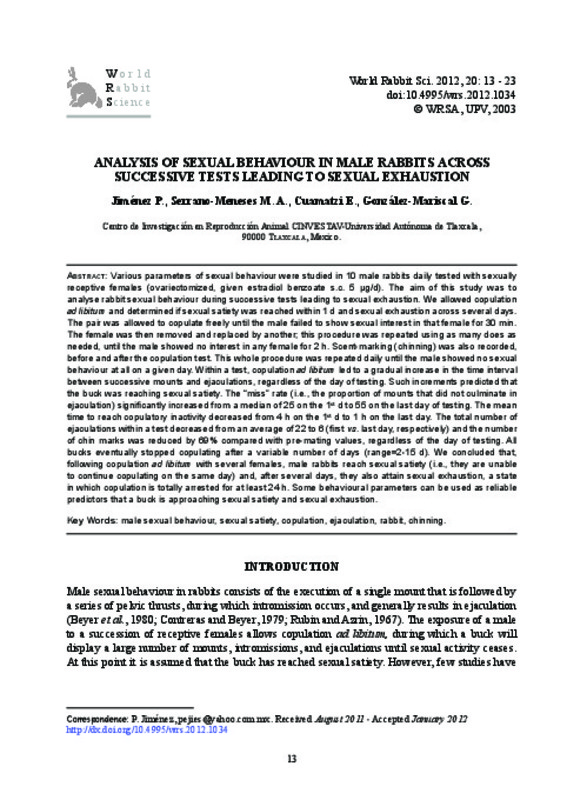JavaScript is disabled for your browser. Some features of this site may not work without it.
Buscar en RiuNet
Listar
Mi cuenta
Estadísticas
Ayuda RiuNet
Admin. UPV
Analysis of sexual behaviour in male rabbits across successive tests leading to sexual exhaustion
Mostrar el registro sencillo del ítem
Ficheros en el ítem
| dc.contributor.author | Jiménez, Pedro
|
es_ES |
| dc.contributor.author | Serrano-Meneses, M.A.
|
es_ES |
| dc.contributor.author | Cuamatzi, E.
|
es_ES |
| dc.contributor.author | González-Mariscal, G.
|
es_ES |
| dc.contributor.author | González-Maris
|
es_ES |
| dc.date.accessioned | 2012-07-18T11:57:55Z | |
| dc.date.issued | 2012-03-30 | |
| dc.identifier.issn | 1257-5011 | |
| dc.identifier.uri | http://hdl.handle.net/10251/16681 | |
| dc.description.abstract | [EN] Various parameters of sexual behaviour were studied in ten male rabbits daily tested with sexually receptive females (ovariectomized, given estradiol benzoate s.c. 5 µg/day). The aim of this study was to analyse rabbit sexual behaviour during successive tests leading to sexual exhaustion. We allowed copulation ad libitum and determined if sexual satiety was reached within a day and sexual exhaustion across several days. The pair was allowed to copulate freely until the male failed to show sexual interest in that female for 30 minutes. The female was then removed and replaced by another; this procedure was repeated using as many does as needed, until the male showed no interest in any female for 2 hours. Scent-marking (chinning) was also recorded, before and after the copulation test. This whole procedure was repeated daily until the male showed no sexual behaviour at all on a given day. Within a test, copulation ad libitum led to a gradual increase in the time interval between successive mounts and ejaculations, regardless of the day of testing. Such increments predicted that the buck was reaching sexual satiety. The "miss" rate (i.e., the proportion of mounts that did not culminate in ejaculation) significantly increased from a median of 25 on the first day to 55 on the last day of testing. The mean time to reach copulatory inactivity decreased from 4 hrs on the first day to 1 hr on the last day. The total number of ejaculations within a test decreased from an average of 22 to 6 (first vs last day, respectively) and the number of chin marks was reduced by 69% compared with pre-mating values, regardless of the day of testing. All bucks eventually stopped copulating after a variable number of days (range=2-15 days). We concluded that, following copulation ad libitum with several females, male rabbits reach sexual satiety (i.e., they are unable to continue copulating on the same day) and, after several days, they also attain sexual exhaustion, a state in which copulation is totally arrested for at least 24 hours. Some behavioural parameters can be used as reliable predictors that a buck is approaching sexual satiety and sexual exhaustion. | es_ES |
| dc.language | Inglés | es_ES |
| dc.publisher | Editorial Universitat Politècnica de València | es_ES |
| dc.relation.ispartof | World Rabbit Science | |
| dc.rights | Reserva de todos los derechos | es_ES |
| dc.subject | Male sexual behaviour | es_ES |
| dc.subject | Sexual satiety | es_ES |
| dc.subject | Copulation | es_ES |
| dc.subject | Ejaculation | es_ES |
| dc.subject | Rabbit | es_ES |
| dc.subject | Chinning | es_ES |
| dc.title | Analysis of sexual behaviour in male rabbits across successive tests leading to sexual exhaustion | es_ES |
| dc.type | Artículo | es_ES |
| dc.date.updated | 2012-07-18T10:55:19Z | |
| dc.identifier.doi | 10.4995/wrs.2012.1034 | |
| dc.rights.accessRights | Abierto | es_ES |
| dc.description.bibliographicCitation | Jiménez, P.; Serrano-Meneses, M.; Cuamatzi, E.; González-Mariscal, G.; González-Maris (2012). Analysis of sexual behaviour in male rabbits across successive tests leading to sexual exhaustion. World Rabbit Science. 20(1):13-23. https://doi.org/10.4995/wrs.2012.1034 | es_ES |
| dc.description.accrualMethod | SWORD | es_ES |
| dc.relation.publisherversion | https://doi.org/10.4995/wrs.2012.1034 | |
| dc.description.upvformatpinicio | 13 | |
| dc.description.upvformatpfin | 23 | |
| dc.description.volume | 20 | |
| dc.description.issue | 1 | |
| dc.identifier.eissn | 1989-8886 |








